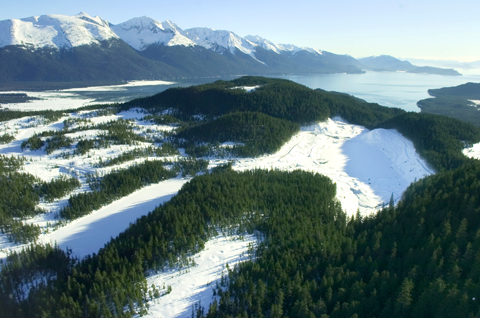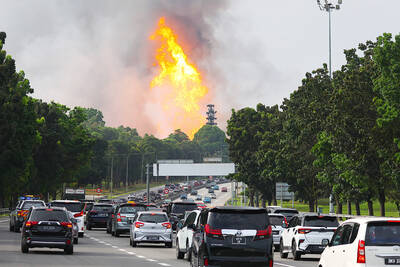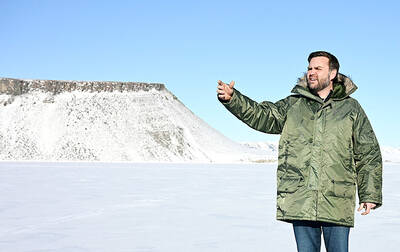A mining company was given the go-ahead by the US Supreme Court to dump waste from an Alaskan gold mine into a nearby 9.3-hectare lake, although the material will kill all the lake’s fish.
The court said on Monday that the federal government acted legally in declaring the waste left after metals are extracted from the ore as “fill material” allowing a federal permit without meeting more stringent requirements from the US Environmental Protection Agency (EPA) under the Clean Water Act.
Alaska Governor Sarah Palin called the decision “great news for Alaska” and said it “is a green light for responsible resource development.” The Kensington Gold Mine, 72.4km north of Juneau, Alaska’s capital, will produce as many as 370 jobs when it begins operation.

PHOTO: AP
Environmentalists feared the ruling could lead to a broader easing of requirements on how companies dispose of their mining waste.
“If a mining company can turn Lower Slate Lake in Alaska into a lifeless waste dump, other polluters with solids in their water can potentially do the same to any water body in America,” said Trip Van Noppen, president of Earthjustice, which had participated in the litigation.
By a 6-3 vote, the Supreme Court said a federal appeals court wrongly blocked on environmental grounds the Army Corps of Engineers’ waste disposal permit for the mine project. The Alaska mine, which had been closed since 1928, now plans to resume operation and will dump about 4.1 million tonnes of mine tailings — waste left after metals are extracted from the ore — into the lake about 5km away in the Tongass National Forest.
The court, in its majority opinion written by Justice Anthony Kennedy, said the Army Corps was correct in agreeing with the mining company that the waste should be considered “fill material” and not subject to the more stringent EPA requirements.
The 2005 permit was issued three years after the former administration of US president George W. Bush broadened the definition of fill material so that waste, including some contaminated materials, can be dumped into waterways.
“We conclude that the Corps was the appropriate agency to issue the permit and that the permit is lawful,” Kennedy wrote.
He said the court should “accord deference to the agencies’ reasonable decision” on the matter.
In a dissenting opinion, Justice Ruth Bader Ginsburg said it is “neither necessary or proper” to interpret the waterway protection law “as allowing mines to bypass EPA’s zero-discharge standard by classifying slurry as fill material.”
She argued the lower court had been correct in concluding that the use of waters as “settling ponds for harmful mining waste” was contrary to the federal Clean Water Act.
Environmentalists said dumping 200,000 gallons (757 liters) a day of mining waste water — containing aluminum, copper, lead, mercury and other metals — has dire implications not only for the Alaska lake, but possibly other lakes and waterways.
Rob Cadmus of the Southeast Alaska Conservation Council said there were better ways to dispose of the mine waste such as dry land storage.
However, the mining firm argued that the alternative would have been to put the material into nearby wetlands, which it maintained was more environmentally harmful.
Officials of the Idaho-based Coeur d’Alene Mine Co, owner of the Alaska mine, said the decision was the last hurdle to building the tailings facility so that mining activities can begin.
The court ruling “confirms that this thoroughly studied permit and plan is the best environmental choice” for disposal of the mine’s waste, said Tony Ebersole, the company’s director of corporate communications.
Company lawyers said in court arguments that after mining activities are halted the lake will be restocked.
“The lake will be as good or better as a fishery than it is today,” Ebersole said.
The waste deposits are expected to raise the lakebed 15.2m to the current lake surface level and eventually triple its size to 24.3 hectares.
The lake contains a variety of common fish that are not expected to survive, court documents show.
Republican Senator Lisa Mur-kowski welcomed the court ruling and said it “resolved the most significant obstacle to the creation of hundreds of direct and indirect jobs and a major boost for the economy of Juneau and Southeast Alaska.”

A fire caused by a burst gas pipe yesterday spread to several homes and sent a fireball soaring into the sky outside Malaysia’s largest city, injuring more than 100 people. The towering inferno near a gas station in Putra Heights outside Kuala Lumpur was visible for kilometers and lasted for several hours. It happened during a public holiday as Muslims, who are the majority in Malaysia, celebrate the second day of Eid al-Fitr. National oil company Petronas said the fire started at one of its gas pipelines at 8:10am and the affected pipeline was later isolated. Disaster management officials said shutting the

US Vice President J.D. Vance on Friday accused Denmark of not having done enough to protect Greenland, when he visited the strategically placed and resource-rich Danish territory coveted by US President Donald Trump. Vance made his comment during a trip to the Pituffik Space Base in northwestern Greenland, a visit viewed by Copenhagen and Nuuk as a provocation. “Our message to Denmark is very simple: You have not done a good job by the people of Greenland,” Vance told a news conference. “You have under-invested in the people of Greenland, and you have under-invested in the security architecture of this

Japan unveiled a plan on Thursday to evacuate around 120,000 residents and tourists from its southern islets near Taiwan within six days in the event of an “emergency”. The plan was put together as “the security situation surrounding our nation grows severe” and with an “emergency” in mind, the government’s crisis management office said. Exactly what that emergency might be was left unspecified in the plan but it envisages the evacuation of around 120,000 people in five Japanese islets close to Taiwan. China claims Taiwan as part of its territory and has stepped up military pressure in recent years, including

UNREST: The authorities in Turkey arrested 13 Turkish journalists in five days, deported a BBC correspondent and on Thursday arrested a reporter from Sweden Waving flags and chanting slogans, many hundreds of thousands of anti-government demonstrators on Saturday rallied in Istanbul, Turkey, in defence of democracy after the arrest of Istanbul Mayor Ekrem Imamoglu which sparked Turkey’s worst street unrest in more than a decade. Under a cloudless blue sky, vast crowds gathered in Maltepe on the Asian side of Turkey’s biggest city on the eve of the Eid al-Fitr celebration which started yesterday, marking the end of Ramadan. Ozgur Ozel, chairman of the main opposition Republican People’s Party (CHP), which organized the rally, said there were 2.2 million people in the crowd, but